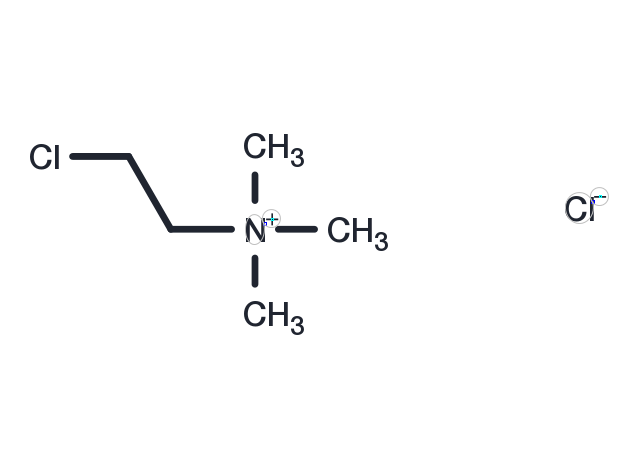Powder: -20°C for 3 years | In solvent: -80°C for 1 year


Chlormequat chloride (EI 38,555), a plant growth regulator, is widely applied in agriculture because it can promote sturdier growth of the crops.

| Pack Size | Availability | Price/USD | Quantity |
|---|---|---|---|
| 1 g | In stock | $ 48.00 | |
| 1 mL * 10 mM (in DMSO) | In stock | $ 45.00 |

| Description | Chlormequat chloride (EI 38,555), a plant growth regulator, is widely applied in agriculture because it can promote sturdier growth of the crops. |
| In vitro | Chlormequat chloride at 150μg/ml (0.93mM) retarded the rat embryo growth without causing significant morphological malformations and at 500μg/ml (3.1mM) caused both retardation and morphological malformation of the embryos. However, the proliferation and differentiation of limb bud cells were not affected by chlormequat chloride at as high as up to 1000μg/ml (6.2mM) applied. This concentration of chlormequat chloride did not affect the cell viability as examined by 3T3 fibroblast cytotoxicity test either, suggesting that cellular toxicity may not play a role in chlormequat induced inhibition of rat embryo growth[1]. |
| In vivo | Chlormequat chloride(5 μg/mL) increased the embryonic growth hormone (GH) and insulin-like growth factor 1 (IGF-1) levels both in vitro and in vivo compared with the control ones[1]. |
| Synonyms | NSC 34858, NSC34858, EI 38,555, NSC-34858, EI-38,555, EI38,555 |
| Molecular Weight | 158.07 |
| Formula | C5H13Cl2N |
| CAS No. | 999-81-5 |
Powder: -20°C for 3 years | In solvent: -80°C for 1 year
DMSO: 65 mg/ml (411.21 mM)
You can also refer to dose conversion for different animals. More
bottom
Please see Inhibitor Handling Instructions for more frequently ask questions. Topics include: how to prepare stock solutions, how to store products, and cautions on cell-based assays & animal experiments, etc.
Chlormequat chloride 999-81-5 Others NSC 34858 NSC34858 EI 38,555 NSC-34858 EI-38,555 Chlormequat Chloride EI38,555 inhibitor inhibit
